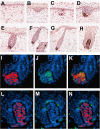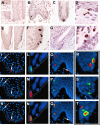Expression of the embryonic stem cell transcription factor SOX2 in human skin: relevance to melanocyte and merkel cell biology
- PMID: 20042675
- PMCID: PMC2808095
- DOI: 10.2353/ajpath.2010.090495
Expression of the embryonic stem cell transcription factor SOX2 in human skin: relevance to melanocyte and merkel cell biology
Abstract
SOX2 is a gene located on chromosome 3q26.33 that encodes a transcription factor important to maintenance of embryonic neural crest stem cell pluripotency. We have identified rare SOX2-immunoreactive cells in normal human skin at or near the established stem cell niches. Three subsets of SOX2-positive cells were defined in these regions: those expressing only SOX2 and those that co-expressed SOX2 and either CK20 or microphthalmia-associated transcription factor, which are consistent with dichotomous differentiation of SOX2-expressing precursors along neuroendocrine (Merkel cell) or melanocytic lines, respectively. Examination of Merkel cell carcinomas confirmed nuclear SOX2 expression in this tumor type. In human patient melanoma, strong nuclear expression of SOX2 was noted in a subset of tumors, and the ability to detect SOX2 in lesional cells significantly correlated with primary tumor thickness in a survey cohort. To assess the potential role of SOX2 in melanoma growth, an in vivo tumorigenesis assay was used. Whereas SOX2 knockdown failed to influence proliferation of cultured melanoma cells in vitro, tumor xenografts generated with the SOX2-knockdown cell line showed significant decrease in mean tumor volume as compared with controls. In aggregate, these findings suggest that SOX2 is a novel biomarker for subpopulations of normal skin cells that reside in established stem cell niches and that might relate to Merkel cell and melanocyte ontogeny and tumorigenesis.
Figures





Similar articles
-
Merkel cells of human oral mucosa express the pluripotent stem cell transcription factor Sox2.Histol Histopathol. 2020 Sep;35(9):1007-1012. doi: 10.14670/HH-18-231. Epub 2020 May 4. Histol Histopathol. 2020. PMID: 32495847
-
SOX2 and nestin expression in human melanoma: an immunohistochemical and experimental study.Exp Dermatol. 2011 Apr;20(4):339-45. doi: 10.1111/j.1600-0625.2011.01247.x. Exp Dermatol. 2011. PMID: 21410764 Free PMC article.
-
SOX2 modulates levels of MITF in normal human melanocytes, and melanoma lines in vitro.Pigment Cell Melanoma Res. 2012 Jul;25(4):533-6. doi: 10.1111/j.1755-148X.2012.01012.x. Pigment Cell Melanoma Res. 2012. PMID: 22571403 Free PMC article. No abstract available.
-
Melanocyte lineage dynamics in development, growth and disease.Development. 2024 Aug 1;151(15):dev201266. doi: 10.1242/dev.201266. Epub 2024 Aug 2. Development. 2024. PMID: 39092608 Free PMC article. Review.
-
Nuclear hormone receptor functions in keratinocyte and melanocyte homeostasis, epidermal carcinogenesis and melanomagenesis.FEBS Lett. 2013 Mar 18;587(6):529-41. doi: 10.1016/j.febslet.2013.01.041. Epub 2013 Feb 5. FEBS Lett. 2013. PMID: 23395795 Free PMC article. Review.
Cited by
-
Genomic evidence suggests that cutaneous neuroendocrine carcinomas can arise from squamous dysplastic precursors.Mod Pathol. 2022 Apr;35(4):506-514. doi: 10.1038/s41379-021-00928-1. Epub 2021 Sep 30. Mod Pathol. 2022. PMID: 34593967 Free PMC article.
-
Progression of cutaneous melanoma: implications for treatment.Clin Exp Metastasis. 2012 Oct;29(7):775-96. doi: 10.1007/s10585-012-9521-1. Epub 2012 Aug 15. Clin Exp Metastasis. 2012. PMID: 22892755 Free PMC article. Review.
-
SOX2 boosts major tumor progression genes in prostate cancer and is a functional biomarker of lymph node metastasis.Oncotarget. 2016 Mar 15;7(11):12372-85. doi: 10.18632/oncotarget.6029. Oncotarget. 2016. PMID: 26540632 Free PMC article.
-
Deciphering the role of transcription factors in glioblastoma cancer stem cells.Acta Biochim Biophys Sin (Shanghai). 2024 May 8;56(9):1245-1255. doi: 10.3724/abbs.2024061. Acta Biochim Biophys Sin (Shanghai). 2024. PMID: 38716541 Free PMC article. Review.
-
Increased expression of melanoma stem cell marker CD271 in metastatic melanoma to the brain.Int J Clin Exp Pathol. 2014 Dec 1;7(12):8947-51. eCollection 2014. Int J Clin Exp Pathol. 2014. PMID: 25674270 Free PMC article.
References
-
- Bittner M, Meltzer P, Chen Y, Jiang Y, Seftor E, Hendrix M, Radmacher M, Simon Rm, Yakhini Z, Ben-Dor A, Sampas N, Dougherty E, Wang E, Marincola F, Gooden C, Lueders J, Glatfelter A, Pollock P, Carpten J, Gillanders E, Leja D, Dietrich K, Beaudry C, Berens M, Alberts D, Sondak V. Molecular classification of cutaneous malignant melanoma by gene expression profiling. Nature. 2000;406:536–540. - PubMed
-
- Hendrix MJ, Seftor EA, Hess AR, Seftor RE. Molecular plasticity of human melanoma cells. Oncogene. 2003;22:3070–3075. - PubMed
-
- Simpson AJ, Caballero OL, Jungbulth A, Chen YT, Old LJ. Cancer/testis antigens, gametogenesis, and cancer. Nat Rev Cancer. 2005;5:615–625. - PubMed
-
- Rothhammer T, Wild PJ, Meyer S, Bataille F, Pauer F, Pauer A, Klinkhammer-Schalke M, Hein R, Hofstaedter F, Bosserhoff AK. Bone morphogenic protein 7 (BMP7) expression is a potential novel prognostic marker for recurrence in patients with primary melanoma. Cancer Biomark. 2007;3:111–117. - PubMed
Publication types
MeSH terms
Substances
Grants and funding
LinkOut - more resources
Full Text Sources

